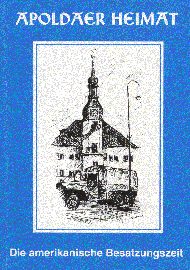
[Also see Do You Remember Apolda?
and Who can help?]
When the Americans Came to Apolda
(Remove "NOSPAM_" from the address when replying.)

[Also see Do You Remember Apolda? and Who can help?] |
|
"When American troops reached the western border of Thuringia at the end of the second World War during the last days of March, 1945, the Wehrmacht and the other German armed forces were no longer in a position to offer strong resistance. The divisions of the American Third Army occupied the individual regions of Thuringia in rapid succession. On April 16th, 1945 the Thuringian area was completely in their hands.
Since April 10th, after the crossing the Werra River near Creuzburg and the occupation of Gotha on April 4th, the American troops concentrated their advance in the direction of the Erfurt-Weimar-Jena area. On April 11th, the 6th Armored Division of the Third Army reached Buchenwald concentration camp by outflanking the town of Erfurt.
In addition, the diary of the Third Army says that on this day the Ulrichshalben/Schwabsdorf area was reached and a prison camp was liberated near Bad Sulza. Another combat unit already reached the Saale River south of Jena on this day. However, they found the bridges destroyed and remained therefore for one night in the vicinity of Göschwitz.
Two infantry regiments of the 80th Infantry Division occupied Erfurt in action on April 12th. Meanwhile, the 319th Infantry Regiment of this division accepted the surrender of Weimar.
In the immediate vicinity of Apolda, SS troops had entrenched and defended themselves in a farmhouse in Niederroßla. On the other hand, in the town of Apolda itself, no Wehrmacht or SS units remained to hold back the approaching American troops. In spite of this, US army units had heard rumors that Apolda would be defended. It remained to be seen whether or not a peaceful surrender of the town could be achieved.
The mayor at that time, Julius Dietz, decided in favor of the surrender of the town. He decided in the interest of the town and its residents, and contrary to the "hold-out" slogans of the Nazi leadership.
By April 11, 1945, the American units were on the advance and the "enemy alarm" was raised in Apolda. Finally, on April 12th, 1945, an exceptionally warm spring day, the time had come. Dietz walked towards to the Americans at noon with a white flag. The residents looked out of their windows and followed his way with their eyes.
Within only few hours, the military administration followed the combat units which had reached the town first. From that point on, numerous American trucks stood at the market place..."With the peaceful surrender of the town began the American occupation of Apolda, which lasted for 82 days and ended on July 2 due to the political decisions of the occupation powers. After that, Thuringia became a part of the Soviet occupation zone.
As a former Apoldaer resident, born in March, 1946, I experienced again and again in the 1950s and 1960s that the role of the US army as an occupation power in East Germany was unspoken; the facts were suppressed.
Every year, the former East Germany (German Democratic Republic, or GDR) observed May 8 as the official "liberation day", and for a long time, it was a national holiday. A crowd of people would walk to the municipal graveyard where there was a memorial for Soviet soldiers killed in action.
In many emotional speeches, the heroic courage of the Soviet "liberators" was commemorated. Such ceremonies took place in the GDR everywhere, even where the Red Army was located only after June/July 1945 according to the Yalta agreement. The only exception to this was commemoration of the historical meeting between Russian and American troops in Torgau, which the GDR leadership later turned to their own political advantage.
The historical events of spring 1945 were described in my school textbooks only as a footnote. On the other hand, much space was devoted to the "American robbery of art, gold, foreign currency, patents, and industrial plants, and Operation PAPERCLIP". Only within these contexts was the presence of the US Army in Thuringia, Saxony-Anhalt, and Saxony mentioned.
Likewise, the freeing of Buchenwald concentration camp on April 11th, 1945, was intentionally exaggerated in the official GDR history as a "revolutionary uprising and complete self-liberation" by the camp inmates under the leadership of the Communists.
It wasn't mentioned that the self-liberation became possible only in the face of the approaching U.S. Third Army which caused the SS to begin to flee. The meaning and role of the US Army was played down or concealed. Hero legends were intentionally fabricated about the Communist resistance in Buchenwald and in other concentration camps, completely in the interest of shaping the anti-fascist political opinion of the GDR population. The GDR defined itself by the anti-fascist resistance of the Communists. Such historical distortions allowed the GDR to place itself on the side of the winners.
The entire official GDR historiography and historical research was influenced by the political situation during the cold war, of the determinant supremacy of the Soviet occupation power, and their political interests and aims. The historiography in the GDR, manipulated for many decades, changed with the political change in 1989. For the first time, many different political opinions began to be expressed. And it turned out that the anti-fascist consciousness of the majority of the GDR population in reality didn't correspond to the former GDR dictions; many views were quite contrary to the official GDR line.
Thomas Bahr began his studies in 1995, when my native town of Apolda was about to celebrate the 50th anniversary of the events of the spring of 1945. Bahr, a regional researcher, searched sources in the town archives and published a "Call for witnesses" in a regional daily paper hoping to get some relevant information. The result of his efforts was extremely modest. With what little material he had (primarily 32 proclamations of the American military government; blurred, subjective narrations of some memory-willing Apoldaer residents; and a copy of the Super Sixth's Armored Attacker from 16 June 1945), Bahr compiled his view of The American Occupation Period.
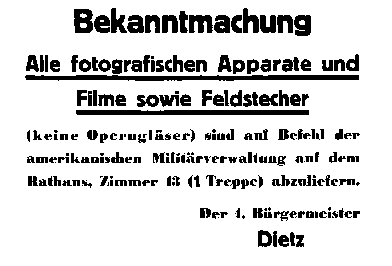 |
This work and its illustrations (such as the notice at left, ordering the confiscation of photography equipment and binoculars), along with an additional contribution and the 32 ordinances mentioned above, was published in Apolda 1995. I was able to provide some photos from the period to illustrate Bahr's book. Bahr is very aware that his work is only a start. |
By referring to George S. Patton's War as I Knew It and other publications, Bahr describes the situation along the front and develops the special situation in and around Apolda in April 1945: From the German point of view he describes the peaceful surrender of the town to the unit led by infantry Major Edwin Trowbridge in the afternoon of April 12, 1945. Bahr subsequently interprets the succeeding weeks of the American occupation and their effect on the German population by means of archive documents.
He describes the cooperation between the official local functionaries and the respective military governors of the town: Major Edwin Trowbridge, who transferred command authority to Capt. C.H. Parker, who was himself replaced by Capt. Marshall, to the last military governor of the town, Capt. Marcinkowski. The author interprets the German position and situation, which he verified on the basis of archive files.
The information available to Thomas Bahr did not allow him to definitely verify the the 6th Armored Division's assignment to Apolda. Because of the ambiguity of his sources, Bahr avoided explicit reference to 6th Armored Division in his article. The only place that the Super Sixth is explicitly mentioned is in the caption of a photograph.
He describes various aspects of the occupation, including supply, personnel, and organizational changes in the municipality, how functionaries under the fascist regime were relieved of their duties, the changing of street names away from their fascist names, etc.
During the days of the invasion of the American troops, many families had burned their books, periodicals, uniform jackets, and other documents of the Nazi time...With the occupation by the American troops, World War II was largely over for Apolda and his inhabitants. For the survivors, the possibility arose for new beginnings...Numerous Apolda residents felt that the end of the war was a defeat for Germany. But the spring of 1945 was instantly recognized as liberation by the prisoners in the concentration camps and penitentaries, as well as by the foreign forced labor inmates...During this time about 30 men and youths drove to Buchenwald concentration camp on the daily Apoldaer marketplace truck. The American armed forces administration had assigned these "Buchenwald workers" to cleaning chores in and around the concentration camp. This group primarily shoveled graves and buried the camp inmates who had died or who had been murdered...

Industrial production had come to a halt in most businesses in the Spring of 1945...Typically, Apolda textile businesses had had no workers and no raw materials as far back as 1942...The armor businesses, like Rhine metal, had produced at top speed within the last months of the war, but it wasn't prepared for a shift to civilian production...One Apolda enterprise, however, continued production at end of the war without interruption: The brewery....From the German viewpoint, he emphasizes the "casual attitude" of the American soldiers, in contrast to the known "snappy attitude" of the Wehrmacht soldiers. He also describes the astonishment and reaction of the residents, who had never before seen black people, upon encountering African-American GIs.
Bahr also reports that often the bad supply situation was improved by
occasional food presents of the GIs to children.
"Mrs Gisela Neubauer tells: 'As I went over to the market, there was a gathering of people... Women and children surrounded an American truck. They laughed and yelled. The children begged for chewing gum and chocolate. They had not known chewing gum until now. Chocolate had never been given to them. On the truck a Negro stood and threw these popular things into the crowd. Now the Negro opened a can with liquid chocolate and poured down it into the crowd. The children and also a couple of women sprang up after this and tried to catch something of the exquisite liquid. This situation was shaming but perhaps also understandable'."Today's interested reader starts to get a picture of the situation at that time: The neglect of the children, the situation of the liberated forced labour prisoners from several regions, the displaced persons, the Germans stranded by the chaos of war, the supply shortages in the hospitals, the return of concentration camp inmates...
The Apolda residents were surprised by the withdrawal of the U.S. Army:
On July 1, 1945, Capt. Marcinkowski informed the residents about the forthcoming
withdrawal. He allowed Germans to move away with the American units, but
only 15 people took advantage of this opportunity.
"The Soviet army came to Apolda on July 2, 1945. The victors of the battles of Stalingrad and Kursk came with horse-drawn carts. This was in marked contrast to the well-equipped, withdrawing US troops."The photos that Thomas Bahr used to illustrate his documentation date from June, 1945. Apolda professional photographer Lisa Liebeskind, who had her own studio, took the pictures. Other Apolda photos by German photographers, and how they viewed this time, are nonexistent. Soon after the occupation the American Military Government confiscated many items: weapons and explosives, of course, but also all privately-owned cameras, binoculars, and radios. Only a few professional photographers were granted permission to work at this time. It is possible that other Apolda photographers took similar photos. However, all originals and copies have probably been lost or destroyed over time, due to lack of interest by their heirs. The only existing photos, which document the presence of the 6th Armored Division, fell into my hands due to the close friendship between the photographer Lisa Liebeskind and my mother, Annemarie Koch.
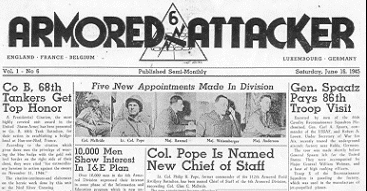 |
Another source of photos was the 6th Armored Division's Armored
Attacker, Vol.1, No.6, Saturday, June 16, 1945, which by chance
remained in private hands and was stored away for 50 years.
We found two other photos from Apolda in this issue.
|
| The first photo, on page 3, is entitled Cooling Off Period, by Army photographer Segui. The accompanying text reads: One of the extra-curricular activities enjoyed by the men of the Division is swimming in the pool at Apolda. In the photo are shown a quintet of water artists from Div. Hq. Rear Echelon... | 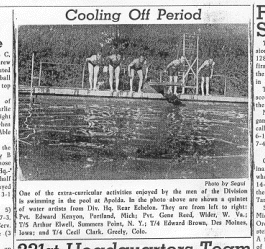
|
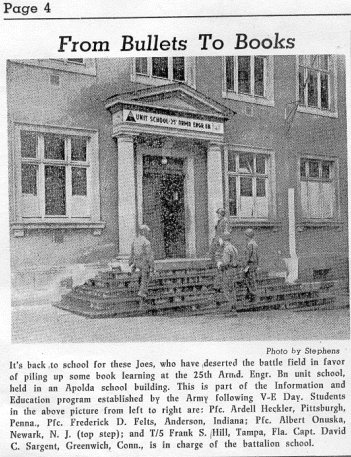 |
The second photo, on page 4, is entitled From Bullets To Books, by Army photographer Stephen. Its text reads, It's back to school for these Joes, who have deserted the battle field in favor of piling up some book learning at the 25th Armd. Engr. Bn unit school, held in an Apolda school building. This is part of the Information and Education program established by the Army following V-E Day... |
Thomas Bahr and I will be planning our next joint research activities. Additional photos and documents from sources in the USA are needed to learn the views and experiences of the GIs at that time, who spent their first days in peace in Apolda.
We sincerely hope that veterans who remember their deployment in Apolda
between April 12, 1945 and July 2, 1945, will consider contacting us. This
is the last opportunity for a conversation between the generations, and
especially between the two generations of two nations.
Who can help?
We are particularly interested in the following information:
We, Dr. Thomas Bahr and Ulrich Koch, hope for the understanding of the veterans of the 6th Armored Division, and hope for your support in our research. We believe that dialog is the way that can help us to close the gaps. We know that within few years, we will no longer be able reconstruct that period in Apolda. It is only possible if we manage to question the still living contemporary witnesses now. Only in such a way, we can process history and understand this history.
Ulrich Koch, Berlin, 3 October 1998
Veterans and their families can contact us at the following address:
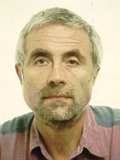 |
Ulrich Koch
Greifswalder Str. 157 D-10409 Berlin Germany Fax: +49-30-42 85 18 07
|
NOTE: Remove question mark from email address below when sending email.
Page maintained by Bruce
Frederick
Last update: November 12, 1998
![]()